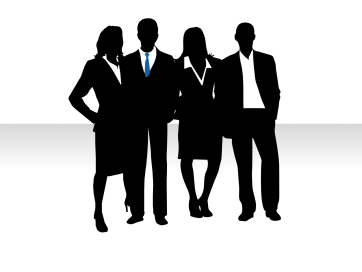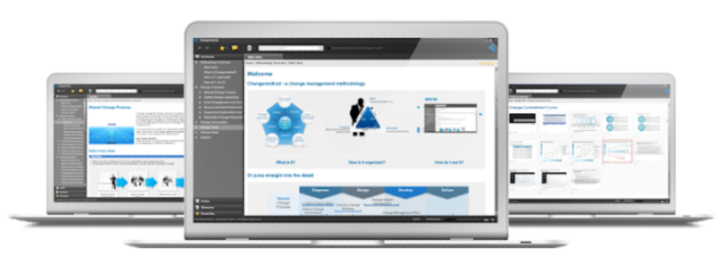Change Management Roles

An organization’s vision of change is realized through its people. A new strategy might light up the way, processes can be adapted and systems integrated but unless the individuals who comprise the organization embrace it all it is unlikely that the change program will deliver its objectives.
In order to mitigate this risk a cast of characters will need to bring different skills together to support the organization’s individuals moving from old ways of working to new.
The roles in this methodology form one part of the methodology triangle. Processes define what you need to do and how to do it, roles tell you who needs to do it and deliverables are what you produce.
Each of the roles describe responsibilities and skill-sets which can then be assigned to an individual and associated with processes and deliverables. An individual may be associated with one or more roles and a role may also be shared by more than one individual.
Area

Role
Business Analyst
Responsibilities
- Identify and analyse requirements
- Design new business processes, performance goals and metrics
Business Consultant
- Define business solutions and structures
- Define opportunities to create business value
- Work with cross-disciplinary teams to create comprehensive change solution
Area

Role
Change Analyst
Responsibilities
- Define and assess impact of change; develop and maintain change management plan
- Review business process design to assess organization and role impacts
- Conduct culture change analysis and coordinate delivery behavior change plan
- Define change measurement plan and develop or source change measurement instrument
- Monitor change progress and highlight where corrective action needed
Change Consultant
- Facilitate future state definition
- Define change program governance
- Understand and evaluate impact of change on stakeholders
- Develop change management interventions to mitigate impact and risk of change
- Design and deliver change leadership assessment
- Prepare and execute change leadership activity plans to support program requirements
- Coordinate change coaching activities to support change leaders
- Conduct culture change analysis and coordinate preparation of behavior change plan
- Define business readiness approach, scorecard and tools
- Monitor change progress and suggest interventions where appropriate
Change Manager
- Define performance issues that to be addressed by change programdefine future state through alignment of capability and behavior requirements; define change program governance; evaluate change impact assessment and develop change management interventions to build commitment and capability; develop change risk mitigation options
- Develop change management strategy and define master change management plan; coordinate change leadership assessment, activity planning and coaching; coordinate training and knowledge strategy and plan; review relevant legal and regulatory requirements arising from the change program; review future state process design, role and job impacts and adapted organization design structures; support transition to ne organization design structures
- Coordinate culture change analysis and behavior change planning; define approach to change measurement, choice of instrument and change measurement plan; evaluate change measurement reports and decide where and how additional change management interventions should be applied; define business readiness approach and oversee development and use of scorecard and measurement tools; understand and plan for change program exit criteria; support change program deployment and post-deployment activities to ensure people and organization adopt and embed the change
Area

Role
Deployment Analyst
Responsibilities
- Gather information from across the organization to support development of deployment approach and plan
- Support the deployment lead and others to execute the deployment plan
Deployment Manager
- Identify, classify and define deployment requirements
- Develop deployment approach and plan
- Agree budget and resources with project, change and additional relevant teams
- Address deployment issues across multiple releases, business units and interdependencies
- Liaise with executive sponsors and change leaders from an early stage to ensure commitment and organizational readiness for change
- Evaluate training and knowledge readiness for deployment
- Design and develop pre-deployment simulation of change solution
- Contribute to change program quality reviews
- Ensure deployment work stream adheres to quality management standards
Area

Role
Executive Sponsor
Responsibilities
- Conduct dialogue with C-suite executives on the strategic context for change, opportunities, risks and associated issues
- Involve senior executives in shaping the vision for change and high level change journey planning
- Evaluate organizational capability and stakeholder commitment for anticipated change journey
- Define overall criteria for success or failure or the change program
- Facilitate the sharing of change best practices and principles amongst senior executives
- Monitor change progress and ensure on-going alignment between change program activity and change program objectives
- Visibly demonstrate support and commitment for change program (time, authority, budget, resources etc)
- Act as point of escalation for business readiness and deployment issues and risks
Area

Role
Human Resources Analyst
Responsibilities
- Identify and analyze key information from across the organization to support HR planning and activity within the change program
- Support the alignment of performance and talent management processes with the change program objectives
- Support the implementation of new organization structures and deployment activity
Human Resources Manager
- Develop HR-oriented change interventions to address impact of change
- Contribute to development and maintenance of change management strategy and plan
- Align change leadership activity with existing leadership framework and protocols
- Identify and communicate HR policies and processes, employee and union relations as well as local and international legal and compliance factors arising from the change program
- Coordinate discussion with employee forums and union bodies where appropriate
- Facilitate organization design activities including job definition, job design, role mapping and team design
- Facilitate estimate of new organization size
- Align performance management and talent management processes with change program objectives
- Prepare inventory of key talent, redundant roles and talent management plan necessary to achieve change program objectives
- Contribute to culture change analysis, behavior change planning and organization transition planning
Area

Role
Training and Knowledge Analyst
Responsibilities
- Identify and analyze key information from across organization to support definition of future skills requirements
- Prepare and deliver current skills assessment to measure baseline skills
- Conduct skills gap analysis
- Facilitate the development of a training and knowledge strategy and plan
- Work with subject matter experts and others to design training and knowledge solution
- Develop and/or source training and knowledge material
- Co-ordinate delivery and evaluation of the training solution
Training and Knowledge Manager
- Develop training and knowledge management oriented change interventions to address impact of change
- Contribute to development and maintenance of change management strategy and plan
- Identify future state knowledge and skill requirements
- Conduct current state knowledge and skill assessment
- Prepare skills development plan to address gap between current and future skills requirements
- Create training and knowledge strategy and plan to support employees’ new ways of working
- Co-ordinate design, development, delivery and evaluation of training and knowledge solution
- Communicate training and knowledge requirements to performance management, talent management and other work streams
- Provide input into culture change analysis and behavior change planning work
Area

Role
Organization Design Analyst
Responsibilities
- Identify and analyze key information from across organization to support design of new organization structures
- Review future state process design for role and organizational impacts
- Facilitate job and team design activity as well as mapping of roles to jobs and reporting relationships
- Facilitate alignment of organizational structures with talent management, performance management and other process design areas
- Provide support during transition from current to future state organization design
Organization Design Manager
- Design new organization structures to meet objectives of change program
- Contribute to development and maintenance of change management strategy and plan
- Evaluate future state process design for role and organizational impacts
- Co-ordinate job and team design activity as well as mapping of roles to jobs and reporting relationships
- Contribute to estimate of future state organization size
- Work with others to align organizational structures with talent management, performance management and other process design areas
- Review key talent inventory and redundancy proposals for impact on organizational structures
- Align organizational structures with desired culture
- Develop transitional structures where appropriate to support smooth transition from current to future state
Area

Role
Project Manager
Responsibilities
- Define project approach, timeline, tasks and resources
- Sign off assumptions underpinning project planning
- Allocate roles and responsibilities; validate project plans with sponsors and stakeholders
- Ensure project resources have necessary skills and ensure training provided where necessary
- Communicate project scope, requirements, plans, resources, training etc.
- Maintain project plan
- Track progress to ensure time, cost, quality, scope and risk factors are balanced
- Take corrective action where appropriate
- Manage change of scope requests through agreed process
- Act as project team point of contact within governance framework; contribute to quality management reviews
- Deliver project capability and business benefits anticipated
Program Manager
- Overall responsibility for program approach, performance of program team and delivery of program capabilities
- Work with change team to establish program sponsorship and governance structures
- Monitor, mitigate and manage issues and risks
- Escalate via change governance structures where necessary
- Ensure sponsors provided with regular and timely insights into program performance
- On-going management of program performance to ensure program benefits delivered within agreed time, cost and quality parameters;
- Develop and/or approve contingency plans where appropriate
- Evaluate impact of program changes on business case
- Communicate revised benefits and value where appropriate
- Act as key point of contact for executive sponsor and change governance team
- Co-ordinate program management operations
- Track program timelines, dependencies and milestones
Area

Role
Stakeholder Engagement Analyst
Responsibilities
- Identify and analyze key information from across organization to support stakeholder analysis activity
- Develop change governance structure roles and responsibilities
- Support development of change governance structure
- Identify potential candidates for change network
- Draft change network roles and responsibilities
- Develop change network education material
- Support change network participants in understanding and fulfilling their roles
- Support development of stakeholder communication strategy, plan and evaluation deliverables
Stakeholder Engagement Manager
- Identify key individual and group stakeholders
- Understand their hopes, fears and motivations
- Assess current levels of commitment and influence over success of change program
- Provide change impact assessment to categorize and evaluate impacts of change by stakeholder or stakeholder group
- Describe change management interventions to address identified impacts
- Suggest additional risk mitigation options per stakeholder group
- Contribute to development and maintenance of change management strategy and plan
- Create stakeholder communication strategy, plan and evaluation deliverables
- Identify candidates, roles and responsibilities for the change network
- Help coordinate development and delivery of stakeholder interventions
- Help shape culture change analysis and behavior change planning
- Suggest change measurement and business readiness metrics relating to stakeholder engagement


